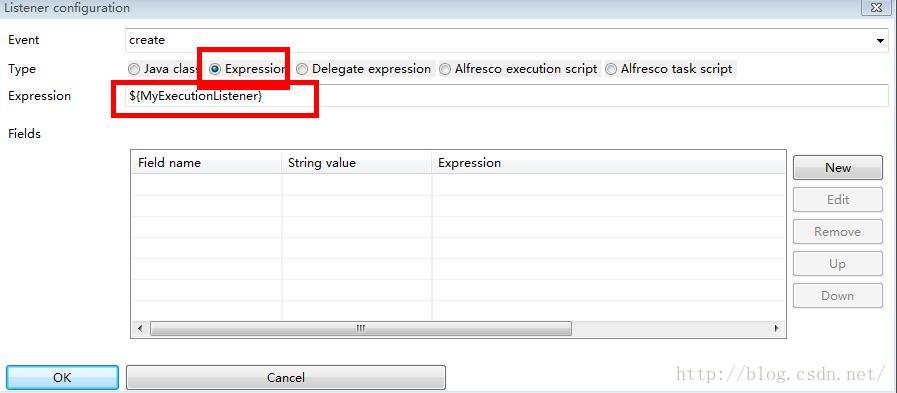activiti监听器使用
Posted 分享牛
tags:
篇首语:本文由小常识网(cha138.com)小编为大家整理,主要介绍了activiti监听器使用相关的知识,希望对你有一定的参考价值。
分享牛原创(尊重原创 转载对的时候第一行请注明,转载出处来自分享牛http://blog.csdn.net/qq_30739519)
activiti使用的时候,通常需要跟业务紧密的结合在一起,有些业务非常的复杂,通常有如下一些场景:
1.activiti人员动态的分配。
2.当前任务节点完成的时候,指定需要指定下一个节点的处理人(比如,一个请假流程,a员工请假,需要指定下一步需要处理请假流程的领导。)。
3.任务节点完成的时候,需要一些复杂业务,(比如当前节点完成的时候,需要调用我们的jms消息系统发送消息)。
4.任务流转到当前的节点的时候,需要监控当前任务节点的一些信息或者其他的业务信息。
5.当前的任务节点分配处理人的时候,需要触发自定义的一些业务。
6.流程开始结束的时候,需要处理业务信息。
7.经过任务节点的出线,也就是连线的时候,需要触发自定义的业务。
那我们怎么实现以上的这些需求呢?这个时候,我们就需要使用activiti监听器,activiti提供的监听器怎么实现,以及如何触发,这些都需要我们一步步了解。下面就详细的介绍activiti监听器。
从 activiti监听器的使用范围来看,大致分为三种:
1.全局的监听器。
2.连线的监听器。
3.节点的监听器。
下面我们一个个的来看如何使用这些监听器。
1.1.1. 全局的监听器
全局监听器主要使用的场景就是监控这个流程的启动和结束。流程开始的时候可以监控,流程结束的时候可以监控,这里说的是流程实例启动结束的监控,并非是流程引擎的启动结束监控。流程引擎的启动结束监控可以参考http://blog.csdn.net/qq_30739519/article/details/51217614 不要混淆了这些概念。
下面我们先定义一个简单的bpmn xml文件看一下如何使用全局的监听器。
全局监听器实现的接口是org.activiti.engine.delegate.ExecutionListener,org.activiti.engine.impl.pvm.delegate.ExecutionListener这个接口新版本已经废弃。
1.1.1.1. ExecutionListener定义
ExecutionListener定义如下:流程实例start、end、take的时候调用。take是监控连线的时候使用的。
public interface ExecutionListener extends Serializable
String EVENTNAME_START = "start";
String EVENTNAME_END = "end";
String EVENTNAME_TAKE = "take";
void notify(DelegateExecution execution) throws Exception;
下面定义一个类监控流程实例的启动监控,看如何使用。
1.1.1.2. 流程图

1.1.1.3. 流程定义xml
流程的xml如下所示:
<?xml version="1.0" encoding="UTF-8"?>
<definitions xmlns="http://www.omg.org/spec/BPMN/20100524/MODEL" xmlns:xsi="http://www.w3.org/2001/XMLSchema-instance" xmlns:xsd="http://www.w3.org/2001/XMLSchema" xmlns:activiti="http://activiti.org/bpmn" xmlns:bpmndi="http://www.omg.org/spec/BPMN/20100524/DI" xmlns:omgdc="http://www.omg.org/spec/DD/20100524/DC" xmlns:omgdi="http://www.omg.org/spec/DD/20100524/DI" typeLanguage="http://www.w3.org/2001/XMLSchema" expressionLanguage="http://www.w3.org/1999/XPath" targetNamespace="daling">
<process id="daling" name="name_daling" isExecutable="true" activiti:candidateStarterUsers="a,b,c,d">
<extensionElements>
<activiti:executionListener event="start" class="com.daling.ch1.listener.MyExecutionListener"></activiti:executionListener>
<activiti:executionListener event="end" class="com.daling.ch1.listener.MyExecutionListener"></activiti:executionListener>
</extensionElements>
<startEvent id="startevent1" name="Start"></startEvent>
<endEvent id="endevent1" name="End"></endEvent>
<userTask id="usertask2" name="User Task"></userTask>
<sequenceFlow id="flow3" sourceRef="startevent1" targetRef="usertask2"></sequenceFlow>
<sequenceFlow id="flow4" sourceRef="usertask2" targetRef="endevent1"></sequenceFlow>
</process>
<bpmndi:BPMNDiagram id="BPMNDiagram_daling">
<bpmndi:BPMNPlane bpmnElement="daling" id="BPMNPlane_daling">
<bpmndi:BPMNShape bpmnElement="startevent1" id="BPMNShape_startevent1">
<omgdc:Bounds height="35.0" width="35.0" x="120.0" y="110.0"></omgdc:Bounds>
</bpmndi:BPMNShape>
<bpmndi:BPMNShape bpmnElement="endevent1" id="BPMNShape_endevent1">
<omgdc:Bounds height="35.0" width="35.0" x="640.0" y="90.0"></omgdc:Bounds>
</bpmndi:BPMNShape>
<bpmndi:BPMNShape bpmnElement="usertask2" id="BPMNShape_usertask2">
<omgdc:Bounds height="55.0" width="105.0" x="300.0" y="90.0"></omgdc:Bounds>
</bpmndi:BPMNShape>
<bpmndi:BPMNEdge bpmnElement="flow3" id="BPMNEdge_flow3">
<omgdi:waypoint x="155.0" y="127.0"></omgdi:waypoint>
<omgdi:waypoint x="300.0" y="117.0"></omgdi:waypoint>
</bpmndi:BPMNEdge>
<bpmndi:BPMNEdge bpmnElement="flow4" id="BPMNEdge_flow4">
<omgdi:waypoint x="405.0" y="117.0"></omgdi:waypoint>
<omgdi:waypoint x="640.0" y="107.0"></omgdi:waypoint>
</bpmndi:BPMNEdge>
</bpmndi:BPMNPlane>
</bpmndi:BPMNDiagram>
</definitions>
1.1.1.4. 监听类
上面我们定义了两个监听器分别指向同一个类com.daling.ch1.listener.MyExecutionListener我们在类中监控事件。
com.daling.ch1.listener.MyExecutionListener类的实现如下所示:
package com.daling.ch1.listener;
import org.activiti.engine.delegate.DelegateExecution;
import org.activiti.engine.delegate.ExecutionListener;
public class MyExecutionListener implements ExecutionListener
public void notify(DelegateExecution execution) throws Exception
String eventName = execution.getEventName();
//start
if ("start".equals(eventName))
System.out.println("start=========");
else if ("end".equals(eventName))
System.out.println("end=========");
1.1.1.5. 开始监控
下面我们部署启动流程看一下效果,部署流程可参考之前的章节,启动流程如下所示:
ProcessInstance processInstance = runtimeService
.startProcessInstanceByKey(key,vars);
我们看一下程序的部分输出如下:
08:34:07.050 [main] DEBUG o.a.e.i.h.DefaultHistoryManager - Current history level: AUDIT, level required: ACTIVITY
08:34:07.056 [main] DEBUG o.a.e.i.h.DefaultHistoryManager - Current history level: AUDIT, level required: ACTIVITY
08:34:07.057 [main] DEBUG o.a.e.i.h.DefaultHistoryManager - Current history level: AUDIT, level required: FULL
start=========
08:34:07.064 [main] DEBUG o.a.e.i.p.r.AtomicOperationActivityExecute - ProcessInstance[107509] executes Activity(startevent1): org.activiti.engine.impl.bpmn.behavior.NoneStartEventActivityBehavior
08:34:07.064 [main] DEBUG o.a.e.i.p.e.J.selectJobsByExecutionId - ooo Using Connection [com.mysql.jdbc.JDBC4Connection@eeb514]
08:34:07.064 [main] DEBUG o.a.e.i.p.e.J.selectJobsByExecutionId - ==> Preparing: select * from ACT_RU_JOB J where J.EXECUTION_ID_ = ?
可以看出流程实例启动的时候,触发了我们自定义的类中的函数。
1.1.1.6. 结束监控
下面我们把usertask的任务结束,然后流程实例结束,看看触发了我们自定义的类中的end没有。
String taskId="107515";
demo.getTaskService().complete(taskId);
我们看一下程序的部分输出如下:
08:39:22.016 [main] DEBUG o.a.e.i.p.r.AtomicOperationActivityExecute - ProcessInstance[107509] executes Activity(endevent1): org.activiti.engine.impl.bpmn.behavior.NoneEndEventActivityBehavior
08:39:22.016 [main] DEBUG o.a.e.i.h.DefaultHistoryManager - Current history level: AUDIT, level required: ACTIVITY
end=========
1.1.1.7. DelegateExecution类
在上面的全局监听器中我们可以拿到DelegateExecution对象,这个对象可以让我们操作activiti引擎中的一些东西,下面看一下DelegateExecution类中的定义。
DelegateExecution类图如下:

启动最常用的方法如下:
/** execution Id */
String getId();
/** 流程实例id*/
String getProcessInstanceId();
/** 这个比较有用 主要就是start、end、take */
String getEventName();
/**
* 业务id已经废弃
*/
String getBusinessKey();
/**
* 业务id */
String getProcessBusinessKey();
/**
* 流程定义id
*/
String getProcessDefinitionId();
/**
* 获取父id,并发的时候有用
*/
String getParentId();
/**
* 获取当前的.Activityid
*/
String getCurrentActivityId();
/**
* 获取当前的.Activity name
*/
String getCurrentActivityName();
/**
* 获取TenantId 当有多个TenantId 有用
*/
String getTenantId();
/**
* 这个非常有用吧。当拿到EngineServices 对象所有的xxxService都可以拿到。
*/
EngineServices getEngineServices();
1.1.2. 连线监听器
当节点结束的时候,经过连线的时候,我们可以在线上定义类,实现自己的业务逻辑。连线监听器怎么实现呢?
这里为了方便测试,我们还是采用上面全局监听器中的流程图,下面我们自定义一个连线监听器类,看看如何使用,可以拿到什么对象。
1.1.2.1. 流程图

1.1.2.2. 流程定义xml
<?xml version="1.0" encoding="UTF-8"?>
<definitions xmlns="http://www.omg.org/spec/BPMN/20100524/MODEL" xmlns:xsi="http://www.w3.org/2001/XMLSchema-instance" xmlns:xsd="http://www.w3.org/2001/XMLSchema" xmlns:activiti="http://activiti.org/bpmn" xmlns:bpmndi="http://www.omg.org/spec/BPMN/20100524/DI" xmlns:omgdc="http://www.omg.org/spec/DD/20100524/DC" xmlns:omgdi="http://www.omg.org/spec/DD/20100524/DI" typeLanguage="http://www.w3.org/2001/XMLSchema" expressionLanguage="http://www.w3.org/1999/XPath" targetNamespace="daling">
<process id="daling" name="name_daling" isExecutable="true" activiti:candidateStarterUsers="a,b,c,d">
<extensionElements>
<activiti:executionListener event="start" class="com.daling.ch1.listener.MyExecutionListener"></activiti:executionListener>
<activiti:executionListener event="end" class="com.daling.ch1.listener.MyExecutionListener"></activiti:executionListener>
</extensionElements>
<startEvent id="startevent1" name="Start"></startEvent>
<endEvent id="endevent1" name="End"></endEvent>
<userTask id="usertask2" name="User Task"></userTask>
<sequenceFlow id="flow3" name="flow3" sourceRef="startevent1" targetRef="usertask2">
<extensionElements>
<activiti:executionListener event="take" class="com.daling.ch1.listener.MyExecutionListener"></activiti:executionListener>
</extensionElements>
</sequenceFlow>
<sequenceFlow id="flow4" sourceRef="usertask2" targetRef="endevent1"></sequenceFlow>
</process>
<bpmndi:BPMNDiagram id="BPMNDiagram_daling">
<bpmndi:BPMNPlane bpmnElement="daling" id="BPMNPlane_daling">
<bpmndi:BPMNShape bpmnElement="startevent1" id="BPMNShape_startevent1">
<omgdc:Bounds height="35.0" width="35.0" x="120.0" y="110.0"></omgdc:Bounds>
</bpmndi:BPMNShape>
<bpmndi:BPMNShape bpmnElement="endevent1" id="BPMNShape_endevent1">
<omgdc:Bounds height="35.0" width="35.0" x="640.0" y="90.0"></omgdc:Bounds>
</bpmndi:BPMNShape>
<bpmndi:BPMNShape bpmnElement="usertask2" id="BPMNShape_usertask2">
<omgdc:Bounds height="55.0" width="105.0" x="300.0" y="90.0"></omgdc:Bounds>
</bpmndi:BPMNShape>
<bpmndi:BPMNEdge bpmnElement="flow3" id="BPMNEdge_flow3">
<omgdi:waypoint x="155.0" y="127.0"></omgdi:waypoint>
<omgdi:waypoint x="300.0" y="117.0"></omgdi:waypoint>
<bpmndi:BPMNLabel>
<omgdc:Bounds height="14.0" width="100.0" x="155.0" y="127.0"></omgdc:Bounds>
</bpmndi:BPMNLabel>
</bpmndi:BPMNEdge>ss
<bpmndi:BPMNEdge bpmnElement="flow4" id="BPMNEdge_flow4">
<omgdi:waypoint x="405.0" y="117.0"></omgdi:waypoint>
<omgdi:waypoint x="640.0" y="107.0"></omgdi:waypoint>
</bpmndi:BPMNEdge>
</bpmndi:BPMNPlane>
</bpmndi:BPMNDiagram>
</definitions>
1.1.2.3. 监听类
上面我们定义了一个监听器com.daling.ch1.listener.MyExecutionListener类中监控事件。
public class MyExecutionListener implements ExecutionListener
/**
*
*/
private static final long serialVersionUID = 7960387497099642910L;
//ExecutionListener类的实现
public void notify(DelegateExecution execution) throws Exception
String eventName = execution.getEventName();
//start
if ("start".equals(eventName))
System.out.println("start=========");
else if ("end".equals(eventName))
System.out.println("end=========");
else if ("take".equals(eventName))
System.out.println("take=========");
因为我们在flow3中定义的监听类,所以流程经过flow3的时候触发定义的take中的自定义事件。
1.1.3. 节点监听器
1.1.3.1. 节点监听器定义
在实际项目开发中,任务节点是经常用到的,所以我们必须要会使用节点监听器。
节点监听器的定义接口org.activiti.engine.delegate.TaskListener,org.activiti.engine.impl.pvm.delegate.TaskListener已经废弃不用。
TaskListener类的定义如下所示:
String EVENTNAME_CREATE = "create";
String EVENTNAME_ASSIGNMENT = "assignment";
String EVENTNAME_COMPLETE = "complete";
String EVENTNAME_DELETE = "delete";
/**
* Not an actual event, used as a marker-value for @link TaskListeners that should be called for all events,
* including @link #EVENTNAME_CREATE, @link #EVENTNAME_ASSIGNMENT and @link #EVENTNAME_COMPLETE and @link #EVENTNAME_DELETE.
*/
String EVENTNAME_ALL_EVENTS = "all";
void notify(DelegateTask delegateTask);
1.1.3.2. 节点监听器类图
节点监听器的子类如下图所示:

下面开始我们详细的使用吧。首先还是定义一个xml,xml流程还是上面所示的,只是多了一些任务节点的监听。
1.1.3.3. 流程图

1.1.3.4. 流程定义xml
流程的xml如下所示:
<?xml version="1.0" encoding="UTF-8"?>
<definitions xmlns="http://www.omg.org/spec/BPMN/20100524/MODEL" xmlns:xsi="http://www.w3.org/2001/XMLSchema-instance" xmlns:xsd="http://www.w3.org/2001/XMLSchema" xmlns:activiti="http://activiti.org/bpmn" xmlns:bpmndi="http://www.omg.org/spec/BPMN/20100524/DI" xmlns:omgdc="http://www.omg.org/spec/DD/20100524/DC" xmlns:omgdi="http://www.omg.org/spec/DD/20100524/DI" typeLanguage="http://www.w3.org/2001/XMLSchema" expressionLanguage="http://www.w3.org/1999/XPath" targetNamespace="daling">
<process id="daling" name="name_daling" isExecutable="true" activiti:candidateStarterUsers="a,b,c,d">
<extensionElements>
<activiti:executionListener event="start" class="com.daling.ch1.listener.MyExecutionListener"></activiti:executionListener>
<activiti:executionListener event="end" class="com.daling.ch1.listener.MyExecutionListener"></activiti:executionListener>
</extensionElements>
<startEvent id="startevent1" name="Start"></startEvent>
<endEvent id="endevent1" name="End"></endEvent>
<userTask id="usertask2" name="User Task" activiti:assignee="c">
<extensionElements>
<activiti:taskListener event="all" class="com.daling.ch1.listener.MyExecutionListener"></activiti:taskListener>
</extensionElements>
</userTask>
<sequenceFlow id="flow3" name="flow3" sourceRef="startevent1" targetRef="usertask2">
<extensionElements>
<activiti:executionListener event="take" class="com.daling.ch1.listener.MyExecutionListener"></activiti:executionListener>
</extensionElements>
</sequenceFlow>
<sequenceFlow id="flow4" sourceRef="usertask2" targetRef="endevent1"></sequenceFlow>
</process>
<bpmndi:BPMNDiagram id="BPMNDiagram_daling">
<bpmndi:BPMNPlane bpmnElement="daling" id="BPMNPlane_daling">
<bpmndi:BPMNShape bpmnElement="startevent1" id="BPMNShape_startevent1">
<omgdc:Bounds height="35.0" width="35.0" x="120.0" y="110.0"></omgdc:Bounds>
</bpmndi:BPMNShape>
<bpmndi:BPMNShape bpmnElement="endevent1" id="BPMNShape_endevent1">
<omgdc:Bounds height="35.0" width="35.0" x="640.0" y="90.0"></omgdc:Bounds>
</bpmndi:BPMNShape>
<bpmndi:BPMNShape bpmnElement="usertask2" id="BPMNShape_usertask2">
<omgdc:Bounds height="55.0" width="105.0" x="300.0" y="90.0"></omgdc:Bounds>
</bpmndi:BPMNShape>
<bpmndi:BPMNEdge bpmnElement="flow3" id="BPMNEdge_flow3">
<omgdi:waypoint x="155.0" y="127.0"></omgdi:waypoint>
<omgdi:waypoint x="300.0" y="117.0"></omgdi:waypoint>
<bpmndi:BPMNLabel>
<omgdc:Bounds height="14.0" width="100.0" x="155.0" y="127.0"></omgdc:Bounds>
</bpmndi:BPMNLabel>
</bpmndi:BPMNEdge>
<bpmndi:BPMNEdge bpmnElement="flow4" id="BPMNEdge_flow4">
<omgdi:waypoint x="405.0" y="117.0"></omgdi:waypoint>
<omgdi:waypoint x="640.0" y="107.0"></omgdi:waypoint>
</bpmndi:BPMNEdge>
</bpmndi:BPMNPlane>
</bpmndi:BPMNDiagram>
</definitions>
1.1.3.5. 监听类
任务节点的监听只要实现TaskListener接口即可。下面是任务监听的实现类,如下所示:
public class MyExecutionListener implements ExecutionListener,TaskListener
/**
*
*/
private static final long serialVersionUID = 7960387497099642910L;
//ExecutionListener类的实现
public void notify(DelegateExecution execution) throws Exception
String eventName = execution.getEventName();
//start
if ("start".equals(eventName))
System.out.println("start=========");
else if ("end".equals(eventName))
System.out.println("end=========");
else if ("take".equals(eventName))
System.out.println("take=========");
//实现TaskListener中的方法
public void notify(DelegateTask delegateTask)
String eventName = delegateTask.getEventName();
if ("create".endsWith(eventName))
System.out.println("create=========");
else if ("assignment".endsWith(eventName))
System.out.println("assignment========");
else if ("complete".endsWith(eventName))
System.out.println("complete===========");
else if ("delete".endsWith(eventName))
System.out.println("delete=============");
当流程运转到usertask2我们看一下程序的输出:
assignment========
create=========
因为usertask2节点配置了处理人所以触发assignment事件监听,当任务运转到usertask2的时候触发了create事件。
这里我们也可以得出一个结论:assignment事件比create先执行。
使用代码结束任务,代码如下:
String taskId="127515";
demo.getTaskService().complete(taskId);
当我们结束usertask2我们看一下程序的输出:
complete===========
delete=============
在这里我们可以得出结论:
任务完成的时候,触发complete事件,因为任务完成之后,要从ACT_RU_TASK中删除这条记录,所以触发delete事件。
1.1.3.6. DelegateTask类
在上面的任务监听器中我们可以拿到DelegateTask对象,这个对象可以让我们操作activiti引擎中的一些东西,下面看一下DelegateTask类中的定义主要访法。
public interface DelegateTask extends VariableScope
/** 数据库中的taskId主键*/
String getId();
/** 任务名称 */
String getName();
/** 修改任务名称 */
void setName(String name);
/** 获取任务的描述信息 */
String getDescription();
/** 修改任务的描述信息 */
void setDescription(String description);
/**
* lower priority: [0..19] lowest, [20..39] low, [40..59] normal, [60..79] high
* [80..100] highest
任务处理的优先级范围是0-100
*/
int getPriority();
/** 修改优先级*/
void setPriority(int priority);
/** 获取流程实例id */
String getProcessInstanceId();
/**获取执行id*/
String getExecutionId();
/** 获取流程定义id*/
String getProcessDefinitionId();
/** Adds the given user as a candidate user to this task. */
void addCandidateUser(String userId);
/** 添加候选人 */
void addCandidateUsers(Collection<String> candidateUsers);
/** 添加候选组 */
void addCandidateGroup(String groupId);
上面我们总结了,全局监听器、连线、任务节点的使用,下面我们看一下共性的东西再做一次总结。
1.1.4. 其他的使用方式
1.1.4.1. spring整合
上面我们在定义类的的时候,我们直接使用的类定义的方式,当然我们还可以跟sring整合使用,因为在实际项目中类的管理可能交给spring容器。使用也很简单如下图所示:

需要填写的表达书,只需要使用spring方式注入即可,$里面的值为需要使用的bean在spring中的id.可以xml定义或者在注解中定义。注解中定义需要开启spring包扫描机制。比如我的@Service("myExecutionListener")。
1.1.5. 小结
1.activiti监听方式分为三大类,节点监听、全局监听、连线监听。
2.activiti监听主要实现的类是两个 节点监听、全局监听实现org.activiti.engine.delegate.ExecutionListener
节点的监听实现org.activiti.engine.delegate.TaskListener接口即可。
3.监听器其实就是一个观察者模式。(关于观察者模式,我们后续章节讲解,限于篇幅有限)
4.监听器获取spring对象,如何获取spring中的bean呢?
1.1.6. 遗留点
5.监听器关于观察者模式,我们后续章节讲解。
6.监听器获取spring对象,如何获取spring中的bean呢?留到下一个章节讲解吧。
以上是关于activiti监听器使用的主要内容,如果未能解决你的问题,请参考以下文章